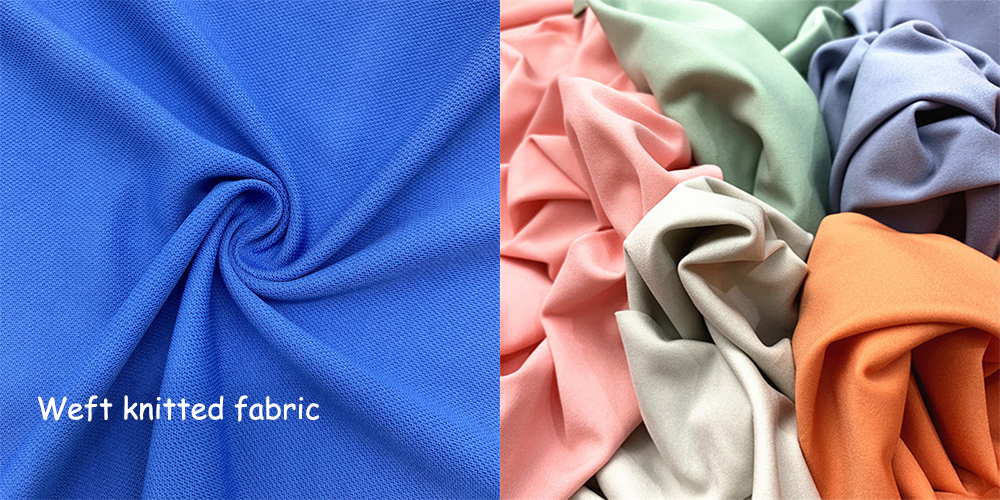
Weft knitted fabric coils are divided into front and back. The side where the coil post covers the previous coil arc is called the front coil; and the side where the coil arc covers the coil post is called the reverse coil.
Single jersey knitted fabrics are knitted using a single bed of needles and are characterized by having all face stitches on one side and all reverse stitches on the other, giving the fabric a distinctly different appearance on both sides. Interlock knitted fabric are knitted using two beds of needles and are characterized by front stitches showing on either side of the knit.
For weft-knitted fabrics, if there are patterns, fluff, etc. on the fabric, you can refer to the method of woven fabrics to distinguish the front and back. For weft-knitted fabrics, since the yarn feeding direction is horizontal during the weaving process, the fabric is prone to transfer during the stress process, so the fabric generally has the characteristic that the horizontal direction is easier to extend than the longitudinal direction. Controlled by production equipment, general weft knitted fabrics can only weave horizontal stripes.
1. Determine whether the fabric is a weft knitted fabric
Adjacent rows in the same row are connected by sinking arcs.
Pulling the yarn along the reverse knitting direction can loosen the loops in the same horizontal direction one by one.
Determine whether the fabric is single jersey or interlock, and determine the technical side of the fabric.
If the front loops are only exposed on one side of the fabric, it is a single-jersey knitted fabric; if the front loops are exposed on both sides of the fabric, it is a interlock knitted fabric.
For single-jersey knitted fabrics, the side where the coil post presses the loop arc is the craft face; for interlock knitted fabrics, generally the side where the needle needs to be selected is the craft face.
2. Determine the weaving direction
Stretch the fabric from the horizontal and vertical directions respectively, observe the coil structure, determine the wale and course direction of the fabric, and try to dismantle the fabric along the upper and lower edges of the longitudinal direction of the fabric to determine the weaving direction.
3. Observe the complete organization and make a mark
For fabrics with obvious weaves, the front of the fabric can be distributed according to the wales of the weaves, and the starting wales and the ending wales can be marked with a marker pen. If the number of fully organized longitudinal lines is large, subdivide marks can be made in units of 5 longitudinal lines or 10 longitudinal lines until the complete tissue is completed.
Then judge whether the fabric is single jersey or interlock, and determine the technical side of the fabric. For fabrics with no obvious structure, you can start from any longitudinal row and mark every 5 or 10 longitudinal row intervals. , determine the width of the complete tissue from the cycle law of each column of coil structure, and then make a formal mark.
If the area of the sample cloth is too large, you can cut out a piece containing several complete weaves, and then try to dismantle it.
4. Disassemble the fabric and record the coil shape
After determining the weaving direction of the fabric, hold the fabric with the left hand, and pull the first yarn that can be detached from the reverse knitting direction of the fabric with the right hand, and gently pull the yarn, and the coils are detached one by one from right to left. At the same time, record the form of each coil (tuck, loop, float) one by one in order from right to left on the Italian paper; and after a yarn is removed, lay the yarn flat, from Start marking, observe the bending state of the yarn, so as to compare and confirm with the previous record.
The number of columns and columns to be analyzed must be more than one complete organization.
For the dismantled yarns, record their specifications one by one in order.
For ribs, double ribs and variable weaves, the needle alignment method for double-sided weaves should be determined first. If the back stitch is between the two front stitches, it is knitting with rib stitches; if the back stitch is at the corresponding position of the front stitches, it is double rib stitch. This type of organization can be represented by a weaving diagram, which is more intuitive.
If you are interested in weft knitted fabric, welcome to contact us. Fuzhou Huasheng Textile., Ltd is committed to providing the high quality fabric and best service to the customer worldwide.
Post time: Jan-18-2023